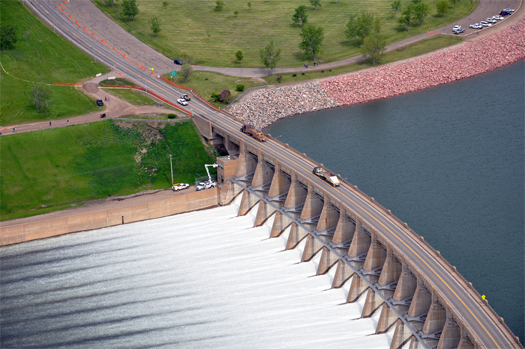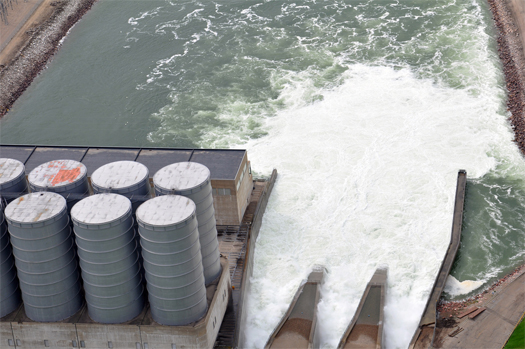The following is a guest post from Nam Henderson, a long-time mammoth commentator and Archinect contributor. Nam blogs at Thoughts on Everything Under the Sun or I am a Guilty Secularist, and this post first appeared there. While I don’t agree with everything the author Nam writes about, William Least Heat-Moon, has to say about the Missouri and it’s current infrastructural condition, both Heat-Moon and Nam raise important issues which are at the heart of debates about the past and present of American flood control.

[Garrison Dam, via Bing Maps.]
I wanted to respond to two of mammoth‘s posts in the floods series, six dams and six reservoirs and dredging fort peck — chiefly, because they allow me an opportunity to refer to a fascinating book I read earlier this year, River Horse: The Logbook of a Boat Across America. Published by Houghton Mifflin in 1999, it was written by Ur-American travel writer William Least Heat-Moon. The book chronicles the author’s successful attempt to cross the USA from East to West traveling solely (and almost completely from coast to coast), by river boat and canoe.
I previously published a short post, Discovering the Garrison Dam, inspired by my ongoing reading of Heat-Moon’s book. In that post, I wrote:
Suffice to say, the tale (particularly the part… regarding the author’s time on the Missouri) is deeply fascinating for what it says about America, rivers, and a sense of nature and place. It especially makes me think about my time in the Midwest and of the fact that my father’s land of birth is up North, near the Missouri headwaters.
Meanwhile, mammoth has argued for viewing this summer’s American floods “not [as] natural disasters, but [as] infra-natural disasters.
What exactly does this mean? As mammoth described it, the infra-natural disaster is a complex hybridized entity: “rather than merely natural disaster; nature may have provided the floodwaters, but the specific velocity and volume of floodwater was produced by the configuration of infrastructural systems, and the confluence of physical and legal infrastructures controlled where disaster appeared.”
Heat-Moon has much to say about this hybrid state of the American waterways. To him, the waters are historic, mythic yet vibrant, urban-rural, wild and natural but also controlled and man-made…


[Garrison Dam releasing maximal water in June of this year; photographs by the US Army Corps of Engineers.]
Mammoth’s six dams and six reservoirs focuses on the six reservoirs of the Upper Missouri — Fort Peck Lake, Lake Sakakawea, Lake Oahe, Lake Sharpe, Lake Francis Case, and Lewis and Clarke Lake. Heat-Moon was about two-thirds of the way through his cross-continental adventure by the time he reached the Upper Missouri. What is interesting about this section of the book, though, is that he describes the flip-side of the condition mammoth has documented this summer. While this summer the Army Corp has been discharging maximal volumes of water from the six reservoirs, during Heat-Moon’s visit the Army Corps was “releasing minimal water” (pg. 303) as a result of high water levels further downstream. (This summer, releasing minimal water is not an option, because of snowpack and heavy rainfall in the upper Missouri basin.) Consequently, Heat-Moon describes his chances of reaching Garrison Dam as “aught to naught”.
Heat-Moon also describes the way the contemporary river has been straightened and regularized by the Corps from an “idly curving conduit” of “ten thousand channels, chutes, islands, towheads, meanders, marshes, backwaters, slackwaters, sloughs, sandbars, and wrenchingly tight bends” (pg. 211). This was done for the purpose of ensuring navigational usage of the river, resulting in what some argue is a market skewing , un-needed high-rate of industry subsidization. Industry groups counter, however, that barging is used chiefly for high volume, bulk commodities — and barging thus earns the support of many environmental groups because it is highly efficient, in terms of energy usage and carbon reduction.
Heat-Moons’ thoughts on this matter, though, are clear. He writes:
Channelizing destroyed thousands of acres of natural habitats, removed spaces that formerly absorbed high waters to lessen the impact of floods, and forced Americans to pay millions of dollars to benefit a few companies and bottom farmers and people who should never have built houses ad businesses in the altered floodplain in the first place (pg. 211).
In my earlier post, I quoted a passage which perfectly illustrates the immensity and scale of our collective conceit:
At about five in the afternoon we saw in the distance the silvery tops of the huge surge tanks of Garrison Dam. More than two miles long and 219 feet high, it is one of the largest [the fifth largest according to Wikipedia] earthern structures in the world, a thing so massive [that], from the river at least, it didn’t look big, any more than, say, North Dakota looks big from a highway; it was just simply everywhere.
And Garrison Dam is just one node within an enormous infra-natural project, which has resulted in the current complex, hybridized system that exists today.


[Garrison Dam releasing maximal water in June of this year; photographs by the US Army Corps of Engineers.]
The river’s hybrid condition does not result, though, solely from the presence of the dams and the regularization of the channel. All manner of industries benefit from subsidies at the river’s expense. Heat-Moon again does not hide his sympathies as he describes how patterns of land use on river adjacent lands have also heavily impacted the riverine ecologies that once existed. At the Charles M. Russell National Wildlife Refuge, cattle subsidized by the antiquated Taylor Grazing Act of 1934 produce manure whose “foul stench… made us hurry our snack” (pg. 253). The gentle absurdity of this observation is balanced by a description of more serious ills result from $500 million dollars in subsidies to corporate cattle operations: “considered against declining species-birds, plants, animals-the need for more meat in this nation is ludicrous; considered against the soil erosion and siltation that cattle create, the consumption of more beef is stupid; considered against the fecal pollution of our waters, the sale of more franchise burgers is criminal.” His solution? “Windmills and pumps should water stock, not natural waterways.” (pg. 353-354)

[Agricultural land on the shores of Lake Sakakawea.]
Consider, in a recent Sunday Edition of the NY Times, an article discussed the possibilities of a new and different era wherein Americans’ relationship with these river(s) could change, for the better. In After Floods, Debate Over Missouri River Rolls On we read:
Asked about the continued emphasis on navigation despite the sparse traffic, Jody Farhat, the chief of water management for the Missouri River Basin for the Army Corps of Engineers, said: “The primary reason is it’s because it’s the law. The Corps of Engineers does what Congress tells us to do.”
1 As a young Corpsman said to Heat-Moon:
“It was just imbecilic to think we could dam off one of the biggest rivers on the planet in fifteen different places and not upset balances…I’m not really an enviro, but if I were, I wouldn’t be running scared. Green thought has the whole natural system on its side — thats about three billion years of trial and error posed against a couple thousand years of human engineering.” (pg. 259)
This passage makes clear the Corps is just serving its mandated purpose. Design-as-intended. As mammoth has elsewhere noted, this “success” points to the fact that the Corps is one of the most pre-eminent organizations of practicing landscape designers in the nation, particularly in terms of scale and ambition. What the above passage and Heat-Moon’s contempt for the Taylor Grazing Act both suggest is that re-shaping the riverine landscape through the legislative, rule-making process — such as by re-orienting the Corps mission or the practices of the Bureau of Landscape Management — could hold the key to the beginning of a re-engagement with the river(s). It could be argued that this sort of affective, political design, is a great example of “going soft“. Dealing not with the hard (current) infrastructural realities (a la dam-busting), but rather reshaping those realities via “soft power and soft politics”. Such a trajectory could be extremely potent — and provide the opportunity to let the fluid, time-tested natural processes act slowly and positively (rather than quickly and disastrously) in a system that has come to be defined by the hard infrastructure of dams and control structures1.

